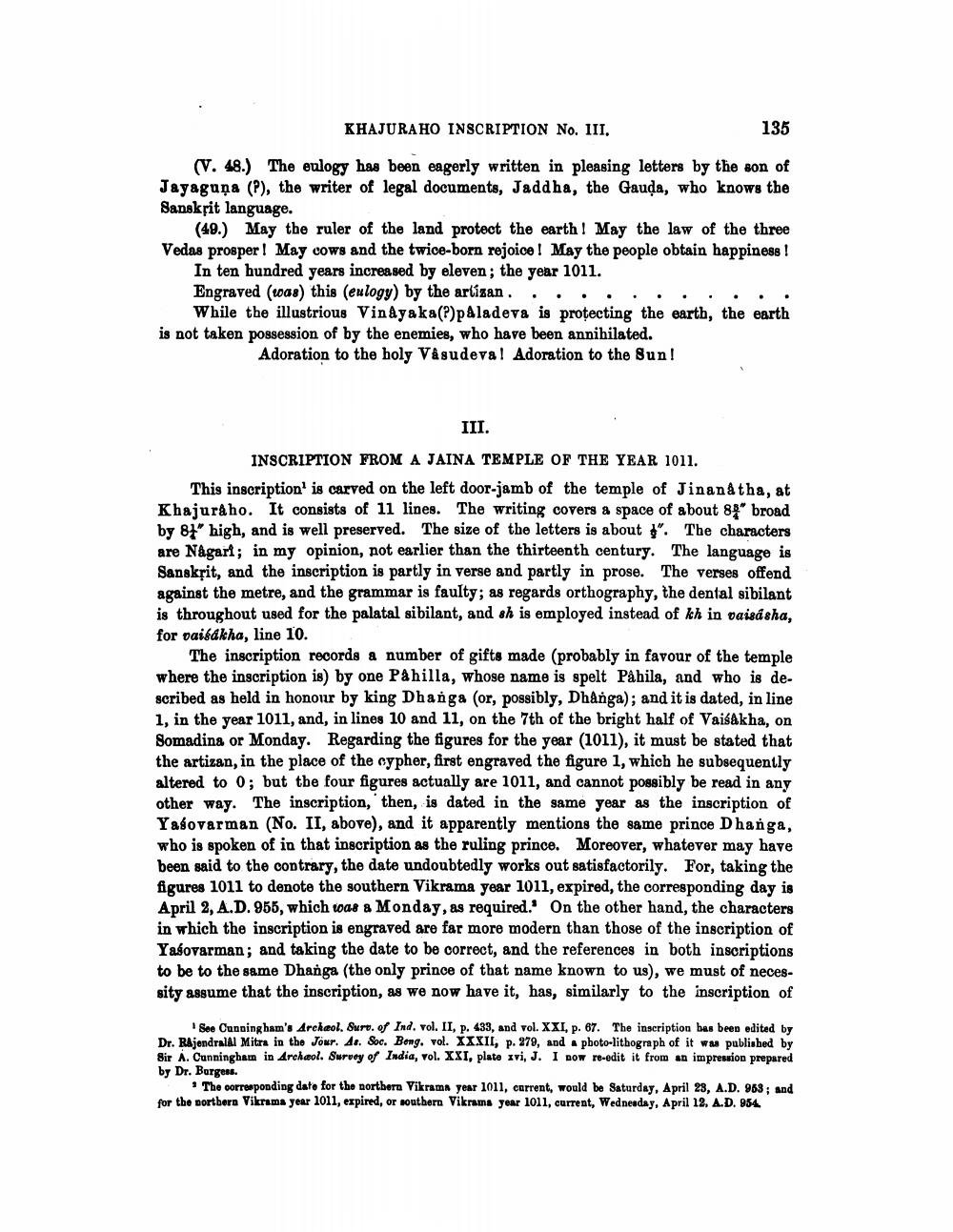________________
KHAJURAHO INSCRIPTION No. III.
135
(V. 48.) The eulogy has been eagerly written in pleasing letters by the son of Jayaguņa (P), the writer of legal documents, Jaddha, the Gauda, who knows the Sanskrit language.
(49) May the ruler of the land protect the earth! May the law of the three Vedas prosper! May cows and the twice-born rejoice! May the people obtain happiness!
In ten hundred years increased by eleven; the year 1011. Engraved (was) this (eulogy) by the artisan. . . . . . . . . . .
While the illustrious Vinayaka(Opaladeva is protecting the earth, the earth is not taken possession of by the enemies, who have been annihilated.
Adoration to the holy Vasudeva! Adoration to the Sun!
III.
INSCRIPTION FROM A JAINA TEMPLE OF THE YEAR 1011. This inscription' is carved on the left door-jamb of the temple of Jinanatha, at Khajuraho. It consists of 11 lines. The writing covers a space of about 89 broad by 87" high, and is well preserved. The size of the letters is about t". The characters are Nagart; in my opinion, not earlier than the thirteenth century. The language is Sansksit, and the inscription is partly in verse and partly in prose. The verses offend against the metre, and the grammar is faulty; as regards orthography, the dental sibilant is throughout used for the palatal sibilant, and sh is employed instead of kh in vaisa sha, for vaisakha, line 10.
The inscription records a number of gifts made (probably in favour of the temple where the inscription is) by one Pahilla, whose name is spelt Påhila, and who is described as held in honour by king Dhanga (or, possibly, Dhanga); and it is dated, in line 1, in the year 1011, and, in lines 10 and 11, on the 7th of the bright half of Vaisakha, on Somadina or Monday. Regarding the figures for the year (1011), it must be stated that the artizan, in the place of the cypher, first engraved the figure 1, which he subsequently altered to 0; but the four figures actually are 1011, and cannot possibly be read in any other way. The inscription,' then, is dated in the same year as the inscription of Yalovarman (No. II, above), and it apparently mentions the same prince Dhanga, who is spoken of in that inscription as the ruling prince. Moreover, whatever may have been said to the contrary, the date undoubtedly works out satisfactorily. For, taking the figures 1011 to denote the southern Vikrama year 1011, expired, the corresponding day is April 2, A.D. 955, which was a Monday, as required. On the other hand, the characters in which the inscription is engraved are far more modern than those of the inscription of Yasovarman; and taking the date to be correct, and the references in both inscriptions to be to the same Dhanga (the only prince of that name known to us), we must of necessity assume that the inscription, as we now have it, has, similarly to the inscription of
See Cunningham's Arckæol. Suro. of Ind. vol. II, p. 433, and vol. XXI, p. 67. The inscription has been edited by Dr. Rajendra Al Mitra in the Jour. As. Soc. Bong. vol. XXXII, p. 279, and photo-lithograph of it was published by Sir A. Cunninghamn in Archæol. Survey of India, vol. XXI, plate zvi, J. I bow re-edit it from an impression prepared by Dr. Burgess.
The corresponding date for the northern Vikrama year 1011, corrent, would be Saturday, April 28, A.D. 963; and for the portbern Vikrama year 2011, expired, or southern Vikrama year 1011, current, Wednesday, April 12, A.D. 954




